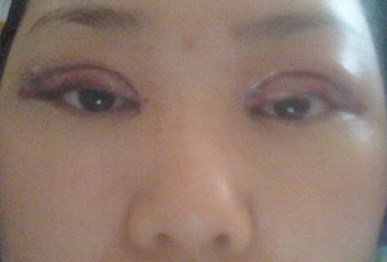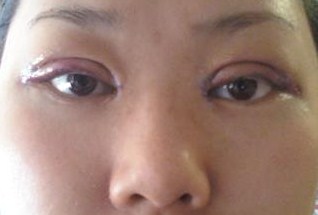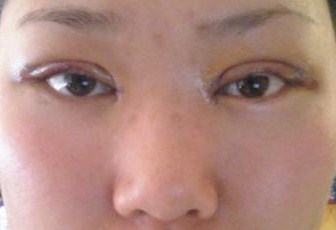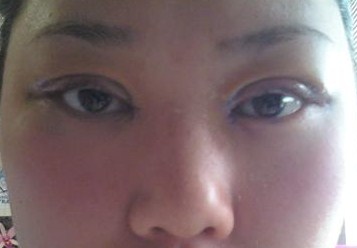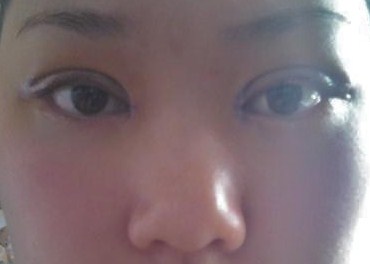Archive for the ‘Asian Double Eyelid Surgery / Asian Eyelid Surgery’ Category
Friday, June 11th, 2010
Some doctors feel that you should repair the ptosis and then do the double eyelid surgery 6 months later. Ptosis Correction with Asian or Double Eyelid Creation can be done in stages but also all at once in my hands. This has not been a problem for me. After reattaching the levator to the tarsus in the best position, I then attach the levator muscle to the orbicularis muscle or skin or whatever technique you use for the double eyelid crease. This has been okay to do for me in my hands. I think some people stage this procedure because they feel that they will have some better control of the results. But I think if you can do it in one procedure why not. You can always stage a revision if the results are not as desirable. But usually one surgery is possible to correct them both with out needing more surgery in my experience. Here is a video of an asian eyelid surgery.
Thanks for reading,
Dr Young
Dr Young specializes in Facial Plastic and Reconstructive Surgery and is located in Bellevue near Seattle, Washington
Posted in Asian Cosmetic Surgery, Asian Double Eyelid Surgery / Asian Eyelid Surgery, Blepharoplasty / Eyelift / Eye Lift / Dark Circles / Eye Bags | Comments Off on Does ptosis repair (for a droopy eyelid) and Asian Double Eyelid Surgery need to be done in a staged fashion?
Monday, June 7th, 2010
The permanent makeup should not make a huge difference in your eyelids unless there is some type of infection after Asian Blepharoplasty (Dr Young Bellevue Wash). An infection would be more likely if there is more tenderness, redness, and swelling than before. You should get some swelling from eyebrow tatooing and this should be expected. Nine days is a little early to do something like that in my opinion. The reason is that after a procedure you will have swelling that is normal. Sometimes the swelling, can break down the skin defenses so it is not a good idea the more closer you do it from your surgery date. I think waiting at least 2 weeks, and to be conservative at least a month from your procedure is the more prudent thing. This is what I would have recommended to you. I would have your doctor examine the area to make sure that there is no signs of infection that would need treatment. Otherwise, I think that you should be okay and that your double eyelid operation should not suffer significant untoward effects. We also have a video demonstrating these procedures for you to see.
Thanks for reading,
Dr Young
Dr Young specializes in Facial Plastic and Reconstructive Surgery and is located in Bellevue near Seattle, Washington
Posted in Asian Double Eyelid Surgery / Asian Eyelid Surgery, Blepharoplasty / Eyelift / Eye Lift / Dark Circles / Eye Bags | Comments Off on The permanent makeup should not make a huge difference in your eyelids unless there is some type of infection
Monday, June 7th, 2010
You can increase the height and style of your double eyelid after Non Incision Asian Blepharoplasty. In this case you wouldn’t absolutely need to remove the sutures that were there before. But removing them would not be very difficult and shouldn’t markedly impact your procedure if it were redone in an open fashion. You can also do the revision with the non incision technique and it should be done just like if your current fold is natural and not from surgery. I prefer doing Asian Blepharoplasty in an open fashion because I think it is more accurate and leads to more reliable results. I don’t know how long you had this procedure but it might have lasted longer had your done the double eyelid procedure in an open manner. To make the crease lower would be much more difficult open and closed. It is not really possible even to make it lower in a closed non incision technique. We also have a video demonstrating these procedures for you to see.
Thanks for reading, Dr Young
Dr Young specializes in Facial Plastic and Reconstructive Surgery and is located in Bellevue near Seattle, Washington
Posted in Asian Double Eyelid Surgery / Asian Eyelid Surgery, Blepharoplasty / Eyelift / Eye Lift / Dark Circles / Eye Bags | Comments Off on You can increase the height and style of your double eyelid after Non Incision Asian Blepharoplasty
Saturday, May 22nd, 2010
The round eye deformity is a consequence of making the double eyelid crease (Philip Young MD from Bellevue, Washington) too high for the particular persons eye shape. What happens is that the eye appears to be much wider in the vertical dimension that appears Round and Odd without the horizontal natural appearing eye that most eyes should have. Usually, most Asian eyelids should have at most 3mm of pretarsal show. That is the amount of eyelid that is showing under the eyelid crease. This area is usually smaller when the eye is open but larger when the eye is closed. The most it should show when the eye is open is 3mm for an Asian Eyelid for an Asian eyelid to look the most aesthetically pleasing. When the eyelid crease is higher than this, the result starts to put more tension toward the medial part of the eyelid. There are solutions to this. You can decrease the height of the eyelid crease so that it looks more natural. Or you can do another procedure, a medial epicanthoplasty which can open up the eyelid more in the horizontal dimension. This helps release the tension that is placed in the epicanthal area. My preference is to do Dr Park’s Z epicanthoplasty. Previous epicanthoplasties were notorious for their propensity to create a lot of scarring. The beauty of Dr. Park’s Z epicanthoplasty, is that it avoids the scarring and keeps the incisions within the double eyelid crease and the natural creases that would normally be created in the eyelid creases. When you look at the picture below, the triangle ECA is removed. The flap made from EAB is rotated into ECA. This effectively helps reduce the prominence of the epicanthal fold and helps open up the eye in the horizontal dimension. We have a video demonstrating these procedures.
Thanks for reading, Dr Young
Dr Young specializes in Facial Plastic and Reconstructive Surgery and is located in Bellevue near Seattle, Washington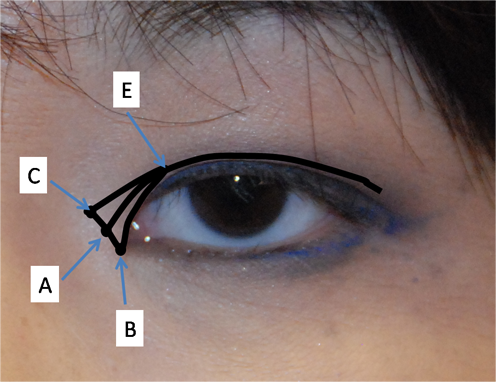
Posted in Asian Double Eyelid Surgery / Asian Eyelid Surgery, Blepharoplasty / Eyelift / Eye Lift / Dark Circles / Eye Bags | Comments Off on What is the Round Eye Deformity and how does a medial epicanthoplasty improve this situation when doing Asian Blepharoplasty?
Thursday, May 13th, 2010
Orbicularis Levator Fixation (Dr Young specializes in plastic surgery of the face and neck and Asian Facial Plastic Surgery) is a technique that I blogged on before. It entails attaching the levator (the eye muscle that opens the eye by lifting the eyelid up) aponeurosis to the orbicularis muscle, which is the muscle that surrounds the eye encircles it and is the primary muscle that helps close the eye and eyelid. With a medial epicanthoplasty, another procedure that I blogged about, you can open up the eyes by increasing the eye’s aperture in the horizontal dimension. The medial epicanthal area is an area that is prone to scar and doing procedures in this area requires a lot of planning and research. In my opinion, the Park Z epicanthoplasty is the best procedure for this area. I show some results of these two combined procedures in the pictures below. The results show that the procedure has incredibly opened up her eyes in a vertical and horizontal dimension. The results have markedly improved her aesthetics. Here is video on Asian Blepharoplasty and Medial epicanthoplasty.
Thanks for reading, Dr Young
Dr Young specializes in Facial Plastic and Reconstructive Surgery and is located in Bellevue near Seattle, Washington
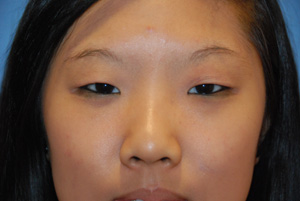
Before
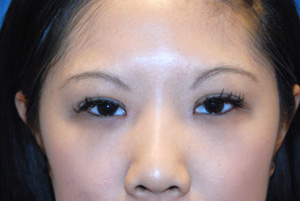
After
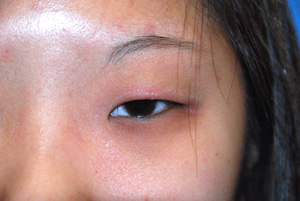
Before
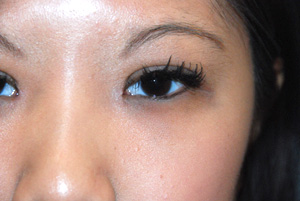
After
Posted in Asian Cosmetic Surgery, Asian Double Eyelid Surgery / Asian Eyelid Surgery | Comments Off on Orbicularis fixation in combination with medial epicanthoplasty can have dramatic results on an Asian Eyelid
Thursday, April 8th, 2010
Recovery from Asian Blepharoplasty (Dr Young is in Seattle Washington) varies and depends on the patient. Generally, the recover takes a week or so. The swelling in the eyes can sometimes take longer to get over depending on your genetics, likelihood of bleeding, your bodies inherent healing properties, etc. Recovery is typically longer than standard blepharoplasty. With Asian blepharoplasty, you have to get to a deeper level in order to recreate the crease. This extra dissection can lead to more swelling, bruising, etc. Techniques to increase the longevity of your crease can add to the healing. But the benefit is that your crease will last longer. I have techniques that make the crease last longer. You can read my blog to find out more about how I do the Asian Blepharoplasty. Another general common understanding of wound healing is that you usually get 60% of your healing the first 6 weeks. You get 80% at 6 months. You have 89% of the healing by 2 years and then it tapers off after that. Look forward to hearing from you!
Thanks for reading, Dr Young
Dr Young specializes in Facial Plastic and Reconstructive Surgery and is located in Bellevue near Seattle, Washington
Posted in Asian Cosmetic Surgery, Asian Double Eyelid Surgery / Asian Eyelid Surgery, Blepharoplasty / Eyelift / Eye Lift / Dark Circles / Eye Bags | Comments Off on What is the recovery for Asian Blepharoplasty?
Friday, March 19th, 2010
This is a question that I answered for a patient regarding whether she should get a lateral epicanthoplasty along with a medial epicanthoplasty and double eyelid crease formation. Lateral Canthoplasty is done the least after Double eyelid crease formation and medial epicanthoplasty. The are good reasons for this. The lateral canthal area is not the area that really defines the differences between an Asian and a Caucasian Eyelid. The medial canthal area is the area where Asians mostly have a difference. It is thought to be due to a lack of development of the nasal bridge or other arrested point. When you are developing all people have epicanthal folds. These folds disappear as you develop in the womb. In Asians, approximately 40-70%, have a persistent fold and they are called epicanthal folds. The lateral canthi don’t have major differences between the two groups. Hence surgical correction of the medial epicanthal folds is where the most difference will be noticed. That is also the reason why doing a lateral epicanthoplasty is a lot likely when one does Asian Blepharoplasty. Another reason that the lateral epicanthoplasties are not done is because they can readhere back to the orginal shape and the success rate is also a lot lower than compared with the medial epicanthoplasty. From your pictures, you have a wide enough horizontal dimension. I think a double eyelid crease procedure and a little medial epicanthoplasty will really improve the appearance of your eyes. Here is video on Asian Blepharoplasty and Medial epicanthoplasty.
I hope that was interesting for you!
Thanks for reading, Dr Young
Dr Young specializes in Facial Cosmetic and Reconstructive Surgery and is located in Bellevue near Seattle, Washington
Posted in Asian Cosmetic Surgery, Asian Double Eyelid Surgery / Asian Eyelid Surgery, Blepharoplasty / Eyelift / Eye Lift / Dark Circles / Eye Bags | Comments Off on Lateral Canthoplasty is done the least after Double eyelid crease formation and medial epicanthoplasty
Sunday, March 14th, 2010
Asian Blepharoplasty can be done with just sutures. One thing to realize is that this method although less invasive is not as reliable and you may end up with the same thing where one side is more defined than the other just the reason that you want sometime done. The surgical method is still minimally invasive and can be done as an outpatient under local anesthesia with or without iv sedation. This method of opening up the eyelid and recreating the crease is more reliable and less likely to have differences between sides. The one option is to do the suture method and see how your healing goes and if it is sufficient for you than that would be the best. If not you might still have the option of opening the eyelid and creating the crease in a more definitive manner.
I hope that was interesting for you!
Thanks for reading, Dr Young
Dr Young specializes in Facial Cosmetic and Reconstructive Surgery and is located in Bellevue near Seattle, Washington
Posted in Asian Cosmetic Surgery, Asian Double Eyelid Surgery / Asian Eyelid Surgery, Blepharoplasty / Eyelift / Eye Lift / Dark Circles / Eye Bags | Comments Off on I don’t want to have a surgical procedure for Asian Eyelift / Blepharoplasty what are my options?
Sunday, March 14th, 2010
This is a question that I answered for a patient:
A double eyelid and a medial epicanthoplasty would be fitting for you. In my opinion and the opinion of many of my colleagues a lateral epicanthoplasty usually leaves something less than desired for many people. What distinguishes an Asian Eyelid from a caucasian eyelid is usually the medial canthus where an epicanthal fold is present in about 50-80% of Asians. This has an effect of making the eyes smaller horizontally. I see the hooded portion in the lateral part of your eye. However, I believe that if you were to do a double eyelid crease formation that part of your eye would be tacked upward and will be markedly improved. I do see that you have an extra fold in the medial part of your eye that is called the epicanthus. Because the picture shows that the fold covers that fleshy part of your eye in the middle part I would classify this as a type 3 epicanthal fold. If it was partially covering the fleshy part it would be classified as a type 2. An epicanthoplasty would open up your eyes horizontally here a great deal. I don’t think you need a brow lift. I think the distance from eyelid margin and your brows is long enough and a brow lift would make you look surprised. I really think that you need some fat in your eyelid or some type of filler there to volumize this area. If you look at some pictures of you when your were a child you will see more fullness there where the volume could recreate some youth for you there. As for the lateral epicanthoplasty, you can always do that later but I really don’t think that it will ever enhance your appearance.
I hope that was interesting for you!
Thanks for reading, Dr Young
Dr Young specializes in Facial Cosmetic and Reconstructive Surgery and is located in Bellevue near Seattle, Washington
Posted in Asian Cosmetic Surgery, Asian Double Eyelid Surgery / Asian Eyelid Surgery, Blepharoplasty / Eyelift / Eye Lift / Dark Circles / Eye Bags | Comments Off on I am wondering if a brow lift, asian double eyelid crease procedure or a epicanthoplasty in the medial or lateral area would make my eyes look better.
